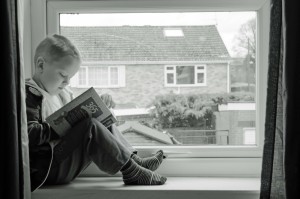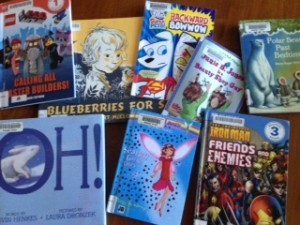Kids and the Decline of Reading, Part 1: What We Can Do At Home

Courtesy: Pixabay
As a mother of a 5- and 6-year-old, I’m always curious about reading trends in the kid world, and how to get children to like reading. I know that reading is on the decline with kids, but I was still slightly appalled to hear about this conversation between my husband and one of the teenaged employees at his quick-service restaurant:
Employee: Has anyone seen The Maze Runner? Is it any good?
Husband: It was pretty good. But you should read the book. It was awesome.
Employee: Why would I read the book when I can just go see the movie?
Husband: Because the book is almost always better than the movie.
Employee: *rolls eyes* Only old people say that.
This struck me to the heart—like a failing pacemaker, I presume, since I’m apparently OLD. Maybe it was the way she said it: very nonchalant, like her viewpoint on the subject was beyond commonplace and she couldn’t believe that adults couldn’t get up to speed on the fact that reading is a last resort for teens.
Maybe it shocked me because just a week before, we had finished an extended family lunch, and when the kids disappeared to do their own things, my thirteen-year-old neice retired to the couch for a bit of texting. Totally nothing wrong with that. Completely natural for a teenager to dash for the phone upon being released from a dinner with the old farts. But I couldn’t help thinking that if that had been me however many years ago, I would have been curled up with a book. And it made me sad. I want my kids to have the same happy experiences with books that I did, and with the advance of technology, that’s becoming less and less likely.
And then, to add insult to mortal injury, I found this dreadful little pictograph at Jane Friedman’s blog (it’s at the top of the post, so you can click over to view it); it shows how books rate in comparison to other interests for kids. As you can see, reading is at the top of most kids’ radar through age 10, after which point it makes a sharp dive until the age of 14, when books don’t even make the top 8.
Maybe I’m the only one, but this FLOORED ME. I think that, despite many conversations on this topic, authors don’t always recognize how widespread and real the disparity is becoming between kids and books. As writers, most of us love to read, and we hang out with people who love to read, and we’re all on a mission to instill a love of reading in our kids, so many of our kids and our friends’ kids like to read. So when we hear about the declining interest in books among teens, we’re all, Oh, that’s awful. But we don’t realize how true it is because we see information to the contrary within our own little authorial bubbles, where books are a huge priority. We don’t really get what it’s like for the rest of the world.
Well, now I get it.
And the question becomes: how do we reverse the decline?
For me, I think the answer is two-pronged, consisting of what we can do at home and what we can do in the industry. This post is already dragging on long enough to turn off avid readers, so today I’m going to address the first point and come back to the second part another time. I’d like to start by sharing some of my personal ideas for raising the value of books and reading at home (or at school). This is a very short, very individualized list of things that have worked for me, so I’m really hoping that you all will add to my ideas in the comments section.
1. Make Reading a Desirable Activity. These days, kids have a lot of choices about how to spend their free time. If they view reading as something boring, it’s always going to be low on their priority list. So come up with ways to make reading a desirable option. My daughter is six, and while she reads well, it’s not her favorite thing to do; she’s incredibly people-oriented and will always choose a social activity over a solitary one, so I’ve had to come up with some underhanded unique ways to get her to read. One thing that has worked really well? I pushed back her bedtime and declared those 15 minutes to be “Reading Time”. She can read during that time, or, if she chooses not to, then she can go to sleep. You can guess what she picks. Now, every night, she reads for at least 15 minutes—sometimes more, if she’s really into her book and it’s not too late. Other ideas I’ve seen is to put books in places where kids spend a lot of time, like the bathroom and the car. Make reading the best possible choice, and they might do it more often.
2. Limit Other Activities. Now, I’m not saying that you throw the phone in the trash, because we don’t want to inadvertently spawn THE APOCALYPSE. But if our kids have access to electronics 24/7, they’re going to use them. And the likelihood of them doing anything else is small. It’s perfectly healthy to implement some electronics-free times or zones where electronics aren’t allowed (unless, of course, they’re being used to read a book). I think we would all be surprised what stimulating, creative, and quality activities kids take part in when phones and tablets aren’t an option. Reading might even be one of them.
3. Read Aloud to Them. I won’t belabor this point, since it’s long been lauded as the #1 way to encourage kids to read. But it’s true. If you want your kids to like books and they’re not old enough or interested enough to read them on their own, read to them. It’s still a great idea when your kids are older, because it enables you to learn which kinds of books they might be most interested in reading.
4. Discuss Books. This point kind of goes along with the last one in that when you discuss a book you’ve read with your child, or a book she’s read on her own, it elevates its value. A book is no longer something that you read to simply say that you read it; it has meaning and messages. It means different things to different people. In today’s technological world, kids are anatomically attached to their phones; connectedness—having access to other people 100% of the time—is a priority for them. Talking about books and stories can be a great way of connecting with your kids and turning a solitary activity into a social one.

My latest haul from the library.
5. Provide Kids With a Variety of Books. I love to read, but I don’t like to read everything. If you told me how awesome reading was and only gave me contemporary fiction, I would probably choose to sleep rather than read. This is one of the main problems I see with the reading programs in school. Kids are often taught to read using boring basal readers and group story books. In middle and high school, they’re forced to read books that they see as outdated and irrelevant, or books that are incredibly hard to understand. And we wonder why they don’t want to read.
Now, allow me to disclaim. I taught school for ten years, so I value what teachers do and I understand the importance of the classics. They teach students many valuable things, but, in most cases, they don’t teach them to love reading. One of the best ways to do that is to provide kids with the kinds of books that they like. If they don’t know which books those are, help them by exposing them to a variety of genres and styles. Get eclectic at the library or bookstore. Bring home books that cover your kid’s favorite hobbies or interests. Try different formats: novels, graphic novels, comic books, nonfiction, and biographies. My son is five and can only read the most basic of books on his own, but we’re reading our way through a Superman sticker book together, and I’m always ready to stop before he is. Explore the different kinds of books out there until you find something your kids love. Then drain that well dry.
6, Model Reading. This is another idea that has been praised to the point of Well, duh. As a teacher, as a mother, I’ve always known that if I want my kids to like reading, they need to see ME reading, see that I enjoy books and value them. I never imagined this being a problem, since reading has always been my #1 leisure activity. But, ironically, things changed when I had kids. Suddenly, I had no time for ANY leisure activities. Reading is the one thing I’ve held onto, but I’m only able to do it before bedtime. As a result, my kids don’t ever see me reading. When I realized this, I made it a priority to sit down at least once a day and read. In car line with my son, at home on the couch, at the park while my kids are playing—even if it’s just for ten minutes, if they can see that I’d rather read than check Facebook or crush candies or watch TV, then it becomes an activity that has value. And they’ll be more likely to explore it for themselves.
These are just a few of the things I’m doing to try and show my kids that reading is fun and books are important. But, honestly, they’re 5 and 6. I’ve heard a lot of stories from parents about how their kids loved books at this age but wouldn’t be caught dead reading for pleasure as a teen. This is an important issue for me, so I’d really love to hear your ideas on how you encourage reading, particularly as they apply to older kids.
The post Kids and the Decline of Reading, Part 1: What We Can Do At Home appeared first on WRITERS HELPING WRITERS™.
Writers Helping Writers
- Angela Ackerman's profile
- 1022 followers



